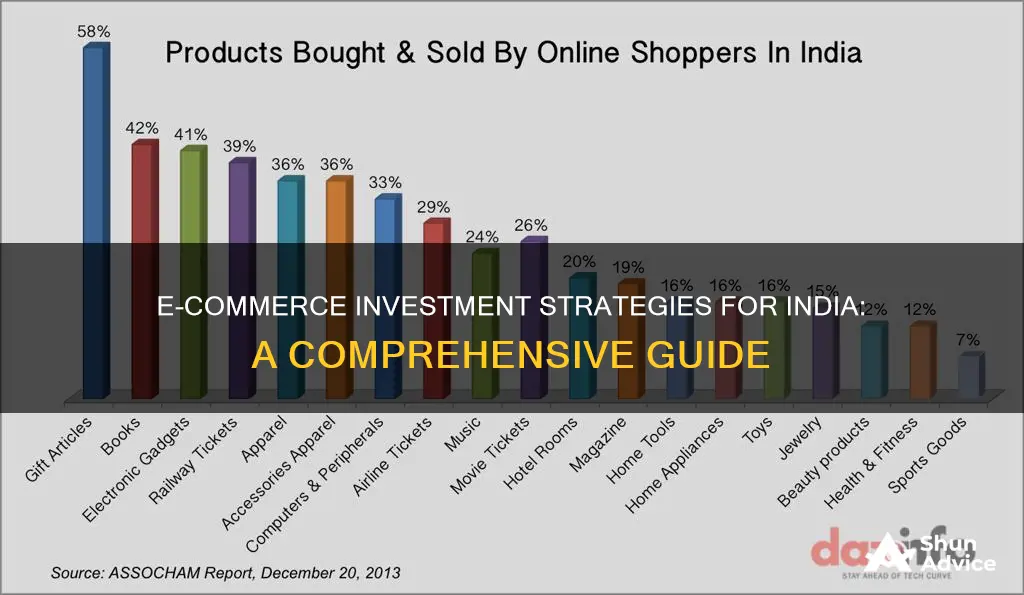
India's e-commerce industry is booming, and it's an attractive prospect for investors. The sector is growing thanks to increased internet and smartphone penetration, rising affluence, and low data prices. The Indian e-commerce industry is projected to reach US$ 325 billion by 2030, and investors are taking note.
The country's online shopper base is expected to be the second largest globally by 2030, with nearly 500-600 million shoppers. This growth is not limited to major cities, as more than 60% of transactions and orders come from tier-two cities and smaller towns.
The Indian government has also been supportive of the e-commerce industry, with initiatives such as the Open Network for Digital Commerce (ONDC), which aims to provide equal opportunities for MSMEs to thrive in digital commerce and democratize the sector.
With the industry's rapid expansion, investors are presented with various options to enter the market, including investing in established e-commerce platforms or acquiring an existing e-commerce store.
What You'll Learn

The benefits of investing in ecommerce in India
India's e-commerce industry is booming, and it offers a plethora of benefits for investors. Here are some advantages of investing in e-commerce in India:
Rapid Growth and High Projections
India's e-commerce industry is experiencing exponential growth, and it is currently the fastest-growing e-commerce market in the world. The industry is projected to reach a market size of $325 billion by 2030, with a compound annual growth rate (CAGR) of 27%. This growth is fuelled by increasing internet penetration, rising smartphone usage, affordable data prices, and increasing purchasing power.
Vast Consumer Base and Expanding Reach
With over 950 million internet users, India is the second-largest internet market globally. The e-commerce trend is not just limited to metropolitan cities but is gaining traction in tier-2 and tier-3 cities, contributing to almost half of all shoppers and orders for leading e-retail platforms. This expansion into smaller cities and towns presents a vast consumer base for businesses to tap into, providing opportunities for increased sales and market penetration.
Enhanced Accessibility and Convenience
E-commerce platforms offer unparalleled convenience and accessibility to consumers. With just a few clicks, shoppers can compare prices, browse a diverse range of products, and make purchases from the comfort of their homes. This convenience is further enhanced by the proliferation of digital payment systems, such as BHIM UPI, which has become a preferred payment method in India.
Cost-Effective Marketing and Expansion Opportunities
For businesses, e-commerce provides a cost-effective gateway to reach a broader consumer base. Online platforms offer marketing channels that are often more affordable than traditional advertising methods. Additionally, e-commerce enables businesses to explore expansion opportunities in various categories and geographical regions without the need for a physical presence in each location.
Government Support and Initiatives
The Indian government has recognised the potential of the e-commerce sector and is actively promoting its growth through various initiatives. These include the Open Network for Digital Commerce (ONDC), which aims to democratise e-commerce and provide equal opportunities for MSMEs to thrive. The government is also backing digital transactions and innovations, such as UPI, RuPay, DigiLocker, and eKYC, to increase their adoption in smaller cities and drive innovation.
Transformative Force and Economic Growth
E-commerce in India is not just a marketplace but a catalyst for economic growth, innovation, and inclusivity. It is transforming the way business is conducted in the country, opening up various segments of commerce, including business-to-business (B2B), direct-to-consumer (D2C), consumer-to-consumer (C2C), and consumer-to-business (C2B). This transformation is expected to drive prosperity and empowerment across the nation.
Kroger Savings Club: A Smart Investment Strategy
You may want to see also

The growth of India's internet economy
India's internet economy is projected to reach $1 trillion by 2030, with its digital sector expected to reach the same value in the same year. This growth is driven by the rapid rise in internet users and smartphone penetration, coupled with increasing incomes. India's internet subscribers are over 969 million as of September 2024, with around 350 million mature online users actively engaging in transactions. The smartphone base is expected to reach 1.1 billion by 2025.
The Indian e-commerce industry is projected to reach US$325 billion by 2030, growing at a compound annual growth rate (CAGR) of 27%. In FY 2022-23, the Government e-Marketplace (GeM) registered its highest-ever Gross Merchandise Value (GMV) of $2011 billion. In FY23, the GMV of e-commerce in India reached US$60 billion, a 22% increase over the previous year. India's online shopper base is expected to be the second largest globally by 2030, with nearly 500-600 million shoppers.
The exponential growth of India's internet economy presents vast opportunities for businesses and consumers. E-commerce provides a gateway for businesses to reach a broader consumer base, utilize cost-effective marketing channels, and explore expansion opportunities. For consumers, e-commerce brings convenience and accessibility, allowing them to compare prices, browse a diverse range of products, and purchase from the comfort of their homes.
Understanding Risk in Investment Management
You may want to see also

The rise of emerging technologies
Artificial intelligence, for example, can be used to analyze consumer behavior and make data-driven decisions about product recommendations, pricing, and promotions. AI can also power chatbots and virtual assistants, enhancing customer support and improving the overall user experience.
Similarly, augmented reality can transform the way products are displayed and experienced online. AR technology allows consumers to visualize products in their own space, providing a more interactive and engaging shopping journey. This is especially beneficial for industries such as fashion, furniture, and home decor, where consumers can virtually try on items or place products in their homes to see how they look and function in a real-world setting.
Additionally, machine learning algorithms can be leveraged to optimize inventory management, supply chain operations, and delivery routes, resulting in increased efficiency and reduced costs for e-commerce businesses. ML models can also identify patterns in consumer behavior, enabling more accurate demand forecasting and personalized marketing campaigns.
The integration of these emerging technologies within the e-commerce sector in India will not only enhance the user experience but also drive operational efficiency, helping the industry sustain its growth trajectory and maintain its competitiveness in the global market.
Value Investing: Why an All-Value Portfolio is a Smart Move
You may want to see also

The impact of ecommerce on traditional retail
The rise of e-commerce in India has had a significant impact on traditional retail businesses, with far-reaching consequences. The growth of online shopping has disrupted the retail industry, challenging traditional retail models and forcing retailers to adapt or struggle to survive.
One of the biggest advantages of e-commerce for consumers is convenience and accessibility. With e-commerce, consumers can browse and purchase products from anywhere, at any time, and often receive their orders on the same day. This level of convenience and accessibility is something that traditional brick-and-mortar stores simply cannot match. Additionally, online shopping makes it easier for consumers to compare prices and products, leading to increased competition and pressure on traditional retailers to offer better value.
The impact of this shift in consumer behaviour is twofold. Traditional retail businesses now face intense competition from online retailers, e-commerce platforms, and big-box stores, which offer a wide range of products, competitive pricing, and convenient shopping experiences. Many customers are opting for the convenience of online shopping, reducing foot traffic to physical stores. This is particularly evident in the example of bookstores, which have seen a decline in visitors due to the popularity of online retailers like Amazon offering a vast selection of books, including digital books, at competitive prices.
However, the rise of e-commerce has also presented traditional retailers with new opportunities. Some retailers have successfully integrated online and offline channels, adopting omnichannel strategies that allow customers to shop online and pick up or return products in-store. This integration provides customers with the convenience of online shopping while also driving foot traffic to physical stores. Additionally, some retailers have invested in creating unique in-store experiences, such as interactive displays, personalized recommendations, and exclusive events, that cannot be replicated online. By focusing on the customer experience, these retailers aim to build a loyal customer base that values the in-person shopping experience.
To adapt to the evolving landscape and remain competitive, traditional retailers must invest in their online presence and e-commerce operations. This includes building user-friendly online stores, optimising the customer journey, and leveraging digital marketing to reach new customers. Retailers can also leverage their physical stores by offering in-store pickup and returns for online orders, reducing delivery times and shipping costs.
In conclusion, the impact of e-commerce on traditional retail in India has been profound, and traditional retailers must embrace this change to thrive in the evolving industry. By understanding the challenges and advantages of e-commerce, traditional retailers can adapt their business models, provide a seamless online and offline shopping experience, and position themselves for success in the highly competitive market.
Understanding Self-Employment Through Investment Management
You may want to see also

The future of ecommerce in India
The future of e-commerce in India looks bright, with the industry experiencing significant growth and transformation. Here are some key factors that indicate a positive outlook:
Rapid Growth and Market Size Projections
India's e-commerce industry is projected to reach a market size of US$325 billion by 2030, showcasing its immense growth potential. This growth is fuelled by increasing internet penetration, rising smartphone usage, affordable data prices, and increasing purchasing power among consumers.
Compound Annual Growth Rate (CAGR)
The Indian e-commerce industry is expected to grow at a CAGR of 27% between 2023 and 2026, reaching US$163 billion. This highlights the industry's rapid expansion over a short period.
Internet and Smartphone Penetration
India has witnessed a boom in internet and smartphone penetration, with about 936.16 million internet subscribers as of June 2023. This number is expected to reach 1.1 billion by 2025. The increasing smartphone base and improved internet connectivity, especially in rural areas, broaden the potential customer base for e-commerce.
Digital Economy and Online Retail
India's digital economy is projected to surge to US$1 trillion by 2030, driven by the strong adoption of online services such as e-commerce and ed-tech. Additionally, India's e-retail market is expected to exceed US$160 billion by 2028, indicating the growing preference for online shopping among consumers.
Government Initiatives
The Indian government has introduced various initiatives to support the growth of e-commerce, including the Digital India, Make in India, Start-up India, Skill India, and Innovation Fund programs. The Open Network for Digital Commerce (ONDC) initiative, launched in 2022, aims to democratize e-commerce and provide equal opportunities for MSMEs to thrive in the digital commerce space.
Foreign Direct Investment (FDI)
The Indian government has increased the limit of Foreign Direct Investment (FDI) in the e-commerce marketplace model to 100% in B2B models, attracting more foreign players to the industry. This is expected to further boost investment and growth in the sector.
Impact on Traditional Retail
The growth of e-commerce is also driving innovation and evolution in the traditional retail sector. Traditional retailers are integrating online channels into their business models and adopting omnichannel strategies to enhance the customer experience and remain competitive.
Emerging Technologies
The rise of emerging technologies such as augmented reality, artificial intelligence, and machine learning will revolutionize the e-commerce industry. These technologies will enable more personalized and immersive shopping experiences for consumers, driving sustained growth and innovation in the sector.
In summary, the future of e-commerce in India is promising, with high growth rates, a rapidly expanding customer base, and technological advancements. The industry is set to benefit from government initiatives, increased FDI, and the transformation of traditional retail. These factors collectively contribute to the positive outlook for e-commerce in India, making it a compelling investment opportunity.
Hedge Fund Managers: Investment Bankers or Something Different?
You may want to see also
Frequently asked questions
The e-commerce industry in India is growing rapidly and is expected to reach US$163 billion by 2026, with a projected market size of US$325 billion by 2030. The industry has been fuelled by increasing internet penetration, rising smartphone usage, affordable data prices, and increasing purchasing power.
The e-commerce industry in India is growing due to increased smartphone penetration, increased affluence, and low data prices. Additionally, the Indian government's initiatives such as Digital India, Make in India, and Start-up India are also supporting the growth of the industry.
The exponential growth of India's internet economy, projected to reach $1 trillion by 2030, presents vast opportunities for investors. E-commerce is at the forefront of this growth, and investors can benefit from the industry's high growth potential and the ability to reach a broader consumer base.
Investing in e-commerce in India offers several benefits, including gaining exposure to an exploding industry, realizing exceptional returns with limited downside risk, and assuming a lean business model with significant residual terms. Additionally, investors can acquire real assets, including digital real estate and intellectual property (IP).
Investing in e-commerce offers several advantages over traditional investments such as stocks or real estate. E-commerce businesses are more affordable, have significant liquidity, and can provide higher returns on investment (ROI) compared to established traditional businesses.







